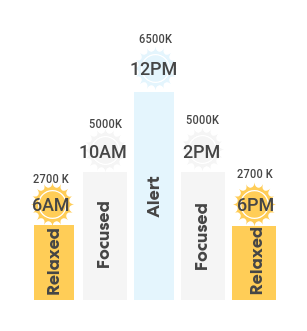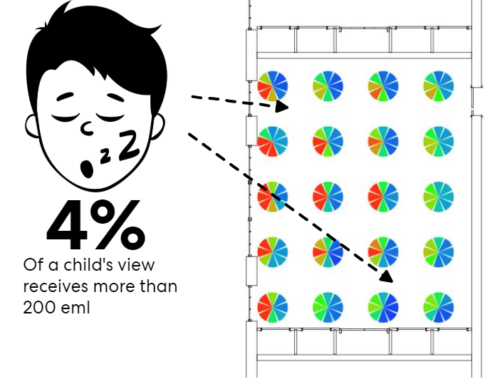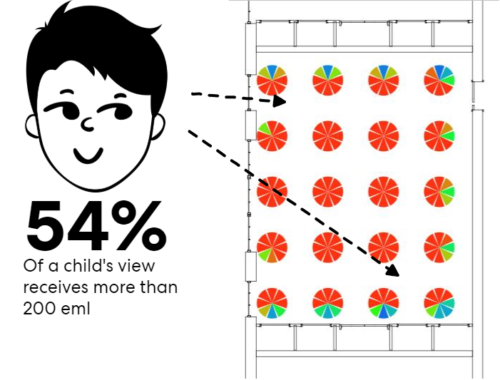Illuminating Health
The impact of daylight on student's health and performance
Contents
What should you know about Daylighting and Schools?
A healthy school is multi-faceted. This series is to provide you with the knowledge and tools to help make healthier decisions every day.
Daylighting
Daylighting is an essential environmental feature for creating a healthy learning space by triggering a hormonal response in people.

Daylighting
Daylighting in schools promotes better learning outcomes. However, it is not a one-size-fits-all solution, so we have six key topics to consider when thinking about daylighting.
A healthy school is multi-faceted. This series is to provide you with the knowledge and tools to help make healthier decisions every day .
What will you learn here?
Contents
What should you know about daylighting?
Daylighting allows us to create a visually stimulating and productive environment.
Daylighting
Daylighting is the controlled admission of natural light; direct sunlight and diffuse skylight—into a building to create a visually stimulating and productive environment for building occupants and reduce electric lighting and save energy.
Six Key Considerations

Temporality

Uniformity

Space-Specific

Controllability

Age Appropriate

Balance
Who is impacted by daylighting?
Contents
What should you know about daylighting in schools?
Windows in your child’s classroom could determine their class participation and ability to sleep at night.
Daylighting
The number, size, and placement of windows in your child’s classroom could determine their class participation and ability to sleep that night.
How does daylight impact us?

Non-visible light without our knowledge can change and regulate the response from our circadian system
Visible light affects how well we can see an object.
Light has both visual and non-visual impacts on the eye and the brain.
In this smart white paper, we focus on the non-visual health effects circadian regulation, alertness, mood, and behavior.
Children are not little adults
Newborns need 16-20 hours of sleep, with time it diminishes to 9 hours for teenagers. This change in circadian rhythm causes challenges in internal clocks that leave students wanting to stay up later but forced to wake up early for school, teenagers have shortened sleep duration, and are not fully rested. Students arrive to school with high levels of melatonin.
Children are more sensitive to daylight exposure than adults because they have larger pupils and have significantly greater light-induced melatonin suppression, with younger children having the greatest circadian-system sensitivity to light exposures.
What is daylight?
Contents
What should you know about daylighting?
Warmer color temperatures (ranging from < 2700K to 3500K) represent daylight hours when the sun is rising and setting when people are falling asleep or waking up.

The chart above shows how different spaces need less of the warmer color temperature and more of the bluer color temperature.
Daylighting
Color temperature influences sleep duration, alertness, hormone production, and executive function.
Terminology
A definition of daylight
Daylight is the volume of natural light that enters a building between sunrise and sunset. Daylighting is the controlled admission of natural light, direct sunlight, and diffused skylight into a facility. For school designers, a proper daylighting strategy can ensure less artificial light energy use. Still, the strategic use of daylight can support children's overall health and wellbeing and improve academic performance.
How do we provide daylight?
• Natural Light
• Direct Sunlight
• Diffused skylight from daylight aperatures, such as windows and skylights
• Artificial lighting provided by electric skylights
How do we achieve good daylighting?
Implementing daylighting on a project goes beyond simply listing the components to be gathered and installed. Good lighting performance requires an integrated design approach.
Factors for achieving good lighting performance
• The geogrphical location considering climate and seasonality
• Shading devices
• The glazing construction materials
• The location, size, and configuration of the windows and skylights
• The interior space configuration
• The construction material light surface reflection of interior finishes
• Daylighting controls
• The school operating schedule and hour of operation
How do we assess the quality of daylight?
A comprehensive way to assess daylight is to look at daylight quantity and daylight quality. Daylight quantity is measured in illuminance or lux. It is the quantity of light coming from all directions and reaching a given point. Quality lighting environments allow students to function comfortably in a learning space, feel safe, and appreciate its aesthetic components. Lighting quality is much more than just providing an appropriate quantity of light.
Factors for governing lighting quality and color
• Color Rendering Index (CRI) measures the color of objects illuminated by a lamp compared to the color of objects illuminated by a reference lamp of the same color temperature.
• Color temperature, measured in units Kelvin, measures the color distribution a light source emits. The higher the color temperature, the bluer the light.
• Light levels or illuminance refers to the magnitude of light per unit area in a room.
• Glare
• Light sources and fixtures
• Light consistency and flicker
• Occupancy expectations
What are the terms to describe how we measure daylight and understand the performance within in a space?
Daylight metrics are tools to evaluate daylighting performance. The goal is to connect building occupants with the outdoors, reinforce circadian rhythms, and reduce the use of electrical lighting:
Daylight metrics
• Illuminance: Illuminance is a photometric term that quantifies light incident on a plane or a surface. It can include contributions from electric light and daylight.
• Daylight Factor (DF): Daylight Factor is the most dominant daylight metric used today due to its simplicity. The daylight factor is the ratio of the light level inside a building to the light level outdoors during an overcast sky condition.
• Daylight Autonomy (DA): Daylight autonomy is the percentage of the operating period (or the number of hours) that a particular daylight level is exceeded throughout the year.
• Useful Daylight Illuminance (UDI): UDI is a location-based dynamic daylight metric that uses actual weather data to produce hourly annual results. UDI measures daylight lux levels deemed 'useful' for occupancy use.
• Spatial Daylight Autonomy (sDA): Spatial daylight autonomy is a dynamic daylight metric that measures the amount of space that receives sufficient daylight. More specifically, it examines the percentage of area that receives 300 lux for at least 50% of the total operational hours measured at working plane ⁵. What sets sDA apart from other dynamic daylight metrics is the incorporation of window blinds. These blinds are set to close and open depending on the amount of direct sunlight the space receives.
• Annual Sunlight Exposure (ASE): Annual sunlight exposure is a dynamic daylight metric that measures the amount of space that receives too much daylight.
• Daylight Glare Probability (DGP): Daylight glare probability quantifies occupants' perceived Glare from daylight at a point-in-time, position in space, and occupant view angle. It is calculated by evaluating the entire visual field of a potential occupant, taking into account the light intensity, size of the glare source, contrast, and its position in the field of view. Expressed from 0 to 1, it ranges from Imperceptible Glare (<0.35), Perceptible Glare (0.35-0.4), Disturbing Glare (0.4-0.45) to Intolerable Glare (>0.45).

Alertness
The design of the classroom, the color temperature of materials, and the lighting quality significantly impact a child's capacity to remain alert throughout the day.
Standards
LEED v4.1 for Schools
ASE (1000, 250) • No more than 10% of the area can receive more than 1,000 lux (93 fc) for 250 hours each year.
WELL Building Standard v3
ASE (1000, 250) • No more than 10% of the area can receive more than 1,000 lux (93 fc) for 250 hours each year.
Illuminance • An average of 175 lux (16 fc) or more measured on the horizontal plane 0.76 m (30 inches) above the finished floor.
U.S. California Title 24 - 2019 Building Energy Efficiency Standards
Daylit Zones
• 75% of the floor area within the primary side-lit daylit zone or skylit daylit zone.
US - Collaborative for High-Performance Schools (CHPS)
Daylight Excess* (Annual DA and DAmax)
• Illuminance target multiplier of 10x (i.e., a 30fc classroom target would use 300fc for Daylight Excess)
Spatial Daylight* Saturation (sDS)
• Greater than 50 to 90% sDS 300/50%
UK - Education Funding Agency (EFA)
Daylight Autonomy (DA) • Minimum 50% of the time for 50% of the working plane, with a target illuminance of 300 lux.
UK - BREEAM
Daylighting uniformity • A ratio of at least 0.3, at least 80% of the room has a view of the sky from desk or tabletop height, and room depth criteria to be satisfied.
Daylight illuminance - average and minimum • A ratio of at least 0.3, at least 80% of the room has a view of the sky from desk or tabletop height, and room depth criteria to be satisfied.
Why should you care about daylighting?
Contents
What should we understand about the impacts on children's health and academic performance?
Poor lighting in schools can have a negative impact on children’s health and academic performance.
Lighting affects children’s health and comfort.
- Children have a higher sensitivity to light because they have smaller pupils and less melatonin suppression than adults, affecting their sleep/wake cycles and circadian rhythm [Reference 1 & 2]
Daylighting
Daylight exposure in students has been associated with reduced low-activity time and increased weekend physical activity. [Reference 3]
Blue enriched light in the morning could make children more stimulated and alert at school compared to those exposed to dim light [Reference 4&5]
Lighting affects children's performance.
Significantly higher scores and fewer typing errors were recorded on a computerized test for students under simulated daylight compared to artificial lighting [Reference 6].
Case Study Classroom in Atlanta, Georgia, Exterior Perspective

Worst Case Scenario
- Location: Atlanta, Georgia USA
- Time: December 21st, 9 AM
- Orientation: West
- Sky Condition: Overcast
Case Study Classroom in Atlanta, Georgia, Interior Perspective

Classroom Dimensions
- Length: 32 feet (9.8 meters)
- Depth: 22 feet (7 meters)
- Window to Wall Ratio: 40%
- Consider targeting more glazing
- in specific locations that maximize
- circadian stimulus through design
- and performance simulations.
Case Study Classroom in Atlanta, Georgia, Interior Perspective

In the morning hours, there is not enough
daylight intensity and color range for the
classroom to provide the right amount of
melanopic lux that a child requires to keep
them alert and focused.
The location will also adversely impact
conditions as children further away from the
glazing will receive even less melanopic lux.
US students showed a 36% increase in oral reading fluency when exposed to high-intensity light, while those in standard lighting conditions increased by only 16% [Reference 7].

The entire classroom can experience good
lighting quality, intensity, and color with
proper natural daylight augmentation design
strategies with proper artificial lighting.
The location has less impact and every child
experiences enough melanopic lux to keep
them alert and focused.
What actions can we make to improve daylighting in our schools?
Contents
Passive Design Strategies
Overview
Exposure to natural light increases performance, concentration, and well-being, which are crucial for student learning. The most advantageous in a classroom is increased concentration.
To improve lighting in a school and reduce energy costs, schools can take advantage of the natural light provided by the sun. It reduces the need for artificial lighting, reducing overall energy use and carbon emissions. Designers can manage heat gain/loss through windows passive design strategies.
Passive daylighting strategies can collect and reflect light throughout the building, but these strategies must work in a specific location and address unique needs. Designers achieve this by incorporating thoughtful passive lighting details.
Building Orientation
Light direction is essential.
The light that comes from the south is usually best for daylighting as sunlight is consistent throughout the day and year. This orientation can also be used for solar heat gain. The light that comes from the north is the next best, as the sunlight is as consistent as the south, just in a lower quantity. The light that comes from the east and west should be avoided if possible.
Sunlight at these orientations is harsh, it only occurs during half the day, and the sun’s height changes throughout the year, making sunlight harder to control. Architects design buildings so that the rooms that require the most daylight (like front entrances) face north or south, while rooms that require less sun (like storage rooms) face east or west.
Windows
Architects use windows with tall head heights to bring as much light into the building as possible.
They can also use uniform windows (horizontal ribbon windows) across the entire façade to light the space evenly. Using glass that admits light but reduces Glare and UV.
Skylights
Skylights allow daylight to enter from above, which is helpful in spaces at the center of the building where light from windows can't reach. As with windows, uniform skylight spacing results inconsistent lighting. Architects can also place skylights high above the floor, allowing the light to diffuse before it reaches the ground.
Clerestories
Windows high above eye level, or clerestories, can light up an entire room. Architects usually combine clerestories with a reflective roof material or paint. The light enters through the clerestories and reflects off the roof, spreading very diffuse light around the room below.
External Shading Systems
At certain times of the day at each orientation, the light will be too bright and may produce an intense glare inside the building. Architects design custom external shading systems to prevent this to protect windows and other transparent openings. These systems usually include a combination of horizontal and vertical elements but vary depending on the geographical location, climate, and building orientation.
Light Shelves
A reflective horizontal shelf placed above windows reduces Glare and directs light deeper into the space.
Solar Tubes
Solar tubes channel sunlight from the roof through a narrow opening. During the day, they look like ordinary ceiling lamps, but the sun rather than electricity powers them. When placed directly above desks, these work well where people need plenty of light.
Light Wall Colors
Light, reflective paint helps light to bounce around the room and makes the space feel brighter.
Daylight Simulation
Modern architecture firms use parametric software to generate optimized daylighting strategies for buildings. Daylight simulation software analyzes the building geometry and calculates the anticipated daylighting levels throughout the building at any given time of year.
Integrate Artificial Light with Natural Light
Obviously, natural light isn't always available at night, on cloudy days, or shorter days in the winter, so schools must supplement with artificial light sources.
especially those tuned to circadian rhythms, for artificial lighting needs.
Using LED lighting can help boost students' learning performance and increase productivity. LED lighting can also help with students' circadian rhythm as it is designed to mimic natural light. This reduces levels of tiredness throughout the day and allows students to remain alert for longer. LED lighting also eliminates the risk of distracting bad-lighting factors such as poor illumination, Glare, flicker, and color imbalance.
LED lights do not flicker or buzz when close to death, they also remain brighter for longer. These lights use significantly less energy than older technologies, thereby reducing building energy consumption.
Sensors
The easiest way to reduce energy costs is to turn off the lights when they are not in use.
